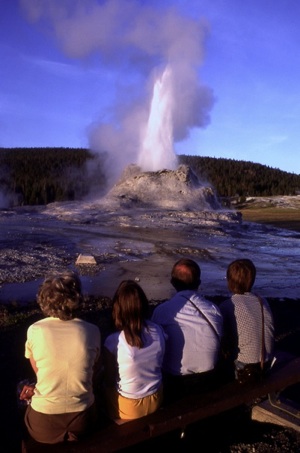There is no more iconic park in the world than Yellowstone National Park. Its earth-shaking geothermal features, wondrous scenery, and rich fount of wildlife are unmatched, and its role as the world’s first national park continues to drive and indeed inspire the parks movement globally.
Spanning 2.2 million acres largely located in northwestern Wyoming, Yellowstone is a precious and astonishing nature preserve, one that constantly delights and challenges visitors to learn more about the natural world.
Here you’ll find Old Faithful and more than 10,000 other geothermal features, the world’s greatest collection. You’ll catch glimpses of wolves, bears, moose and bison as they’ve roamed America’s Serengeti for centuries. And the adventurous have expansive wilderness lands for exploration, retrospection, and introspection.
In Yellowstone you walk among geysers, hot springs, mudpots and fumaroles that bubble to the surface, fueled by a magma pocket not far below ground level. There are thick lodgepole pine forests, aspen glades, and vast rolling meadows. Mountains rise more than 11,000 feet above sea level, while the colorful canyon cut by the Yellowstone River plunges more than 1,000 feet.
So flush with wildlife is this park—along with the wolves, bears, moose and bison, there are elk, mountain lions, bighorn sheep, pronghorn antelope, Canada lynx, coyotes, fox and even wolverines—that there is no better place to indulge in a game or three of wildlife bingo.

Museum of the National Park Ranger. NPS photo by Jim Peaco.
Fittingly, the Museum of the National Park Ranger stands in Yellowstone near the Norris Geyser Basin. Located in the original Norris Soldier Station, this museum tracks the development of the park ranger profession from its roots in the military traditions that guarded Yellowstone through early rangers and to the present array of National Park Service staff with their specialized duties.
Befitting the park’s venerable standing, Xanterra Parks & Resorts sees that you have a wide range of lodging available, from plank-built cabins with woodstoves for warmth to presidential suites. Whichever mode of accommodation you choose, though, you’ll come away from a Yellowstone visit with an appreciation of a quintessential national park that many visitors call their favorite.
How best to explore Yellowstone? Take to heart some of these tips from the Yellowstone Park Foundation:
Don’t be intimidated. A huge park at more than 2.2 million acres, Yellowstone can be daunting to visitors. But it doesn’t need to be.

Take a dip in the Firehole Swimming Area. NPS photo.
Cool off in summer with a dip in the Firehole Swimming Area located a mile south of Madison Junction on Firehole River Drive.
Explore the short (0.6 mile) Fountain Paint Pot Nature Trail, a great walk for the entire family that shows off more than a dozen geothermal features.
Check with the Old Faithful Visitor Education Center for the next eruption of Castle Geyser. This icon goes off every 9-11 hours, shoots water 60-90 feet high, and performs for about 20 minutes.

Don't miss Castle Geyser. NPS photo.
Rise early, before dawn, to reach the Lamar Valley in time to see wolves, elk, bison and other wildlife, then head back to your lodge for a quiet breakfast while everyone else hits the road.
On rainy days, retreat to the second floor mezzanine lounge at the Old Faithful Inn with a warm drink, a good book, or to play a game of checkers.
Stop for a picnic lunch at the Yellowstone River picnic area 1.5 miles west of Tower. After lunch, walk south of the picnic tables for dramatic (and often overlooked) views of the Yellowstone River Canyon. Eagles, elk, bison, grizzly and black bears can often be spotted nearby.
Coming Wednesday: The first of our two-part roundup of Discriminating Explorer experiences from national park friends groups.


 Support Essential Coverage of Essential Places
Support Essential Coverage of Essential Places







Comments
I would add to this, go to Norris Geyser Basin on a full-moon night.
And don't leave without seeing at least one eruption of Grand Geyser.